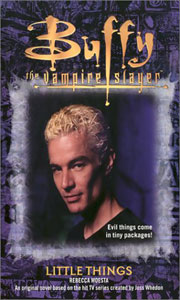Until the recent “High School Years” comics, the makers of “Buffy” spinoff fiction didn’t consistently commit to the young-adult genre. In the YA line of novels, you never knew if you were going to get a slightly shorter adult novel or something that truly was aimed at young readers. Perhaps this is why the YA line ended six years before the adult line. Ironically, the last entry – Rebecca Moesta’s “Little Things” (August 2002) – fits the YA mold the best of any “Buffy” book.
We see YA versions of all the characters – everyone is broadly characterized and dealing with relatable real-world issues. Buffy has a toothache but tries to tough it out. Willow does spells. Spike and Xander toss basic snark at each other. The Scooby Gang throws out quips as if such language is required of them, rather than something that flows naturally. For all these reasons, “Little Things” could be an entry point for the youngest possible “Buffy” fan, except that Anya speaks of her desire to have sex with Xander, which isn’t quite YA-appropriate.
The notion that in takes place in late Season 5, after Joyce’s death, makes “Little Things” particularly absurd. It would’ve played much better if set in Season 1. “Little Things’ ” plot of fairy vampires invading Sunnydale might work as a short story, but it wears extremely thin over the course of 198 pages.
The idea of the gang facing tiny adversaries has been done a lot in the spinoff fiction, as authors made up for the fact that small villains were cost-prohibitive on the TV show’s special effects budget. The villain of “Fear, Itself” (4.4) is miniscule, but we don’t see that until the final scene. The first “Buffy” comic story, the first YA novel and the first adult novel all feature tiny villains like gnomes or faeries. Also popping into my head are the comic yarns “Ugly Little Monsters” and “The Latest Craze.”
Moesta tries to explore the theme of how little things – Buffy’s toothache, Giles’ parking ticket, Xander and Anya’s ant infestation — can grow into big problems, but she does it in clunky fashion, having the Scoobies verbalize the theme. The microvamps who bring this metaphor to life are as annoying to the reader as they are to the Scoobies. They are like larger mosquitoes.
The Scoobies’ strategy for fighting the microvamps is rather stupid. They use toothpicks to stake them. If you’ve ever run around your apartment trying to catch a roach or small bug, you’ll recognize the absurdity of this strategy. For one, it would be near impossible to target the heart on such a small creature. For another, why bother? Just smash the microvamps. I know that doesn’t fit with the established ways to kill vampires, but I gotta think being smashed flat would kill anything. If not, burn the bodies while they are flattened; fire kills vampires.

Aside from satiating one’s curiosity of what a true young-reader “Buffy” novel is like (aside from Anya’s comments), there’s nothing to recommend “Little Things,” the most skippable Buffyverse novel I’ve come across in my re-read.
Click here for an index of all of John’s “Buffy” and “Angel” reviews.

